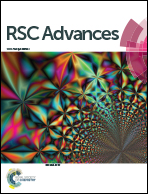Comparative supercapacitance performance of CuO nanostructures for energy storage device applications†
Abstract
In the present study, three different morphologies of copper oxide (CuO) nanostructures; bud-, flower- and plate-shaped CuO structures were synthesized by a simple chemical method. Binder-included pseudocapacitor electrodes were prepared using bud- and flower-shaped CuO structures whereas, directly grown CuO-nanoplates on Ni foam were used as a binder-free electrode in a three-electrode setup for electrochemical studies. Remarkably, the binder-free CuO nanoplates electrode exhibited excellent specific capacitance of 536 F g−1 at a current density of 2 A g−1, whereas the binder-included electrodes of bud- and flower-shaped CuO exhibited 230 F g−1 and 296 F g−1, respectively, at a current density of 0.7 A g−1 in a 6 M KOH electrolyte. The cycling retention test and charge/discharge stability for the binder-free CuO nanoplates electrode showed 94% capacity retention after 2000 cycles and capacitance loss of only 11.3% over ∼1000 cycles at a current density of 4 A g−1 from charge/discharge measurements. Also, the binder-free CuO electrode showed higher energy and power densities of 29.4 W h kg−1 and 12.7 W kg−1, respectively, at 1.96 A g−1 in an asymmetrical device, when compared to the binder-included electrode of flower-shaped CuO.


 Please wait while we load your content...
Please wait while we load your content...